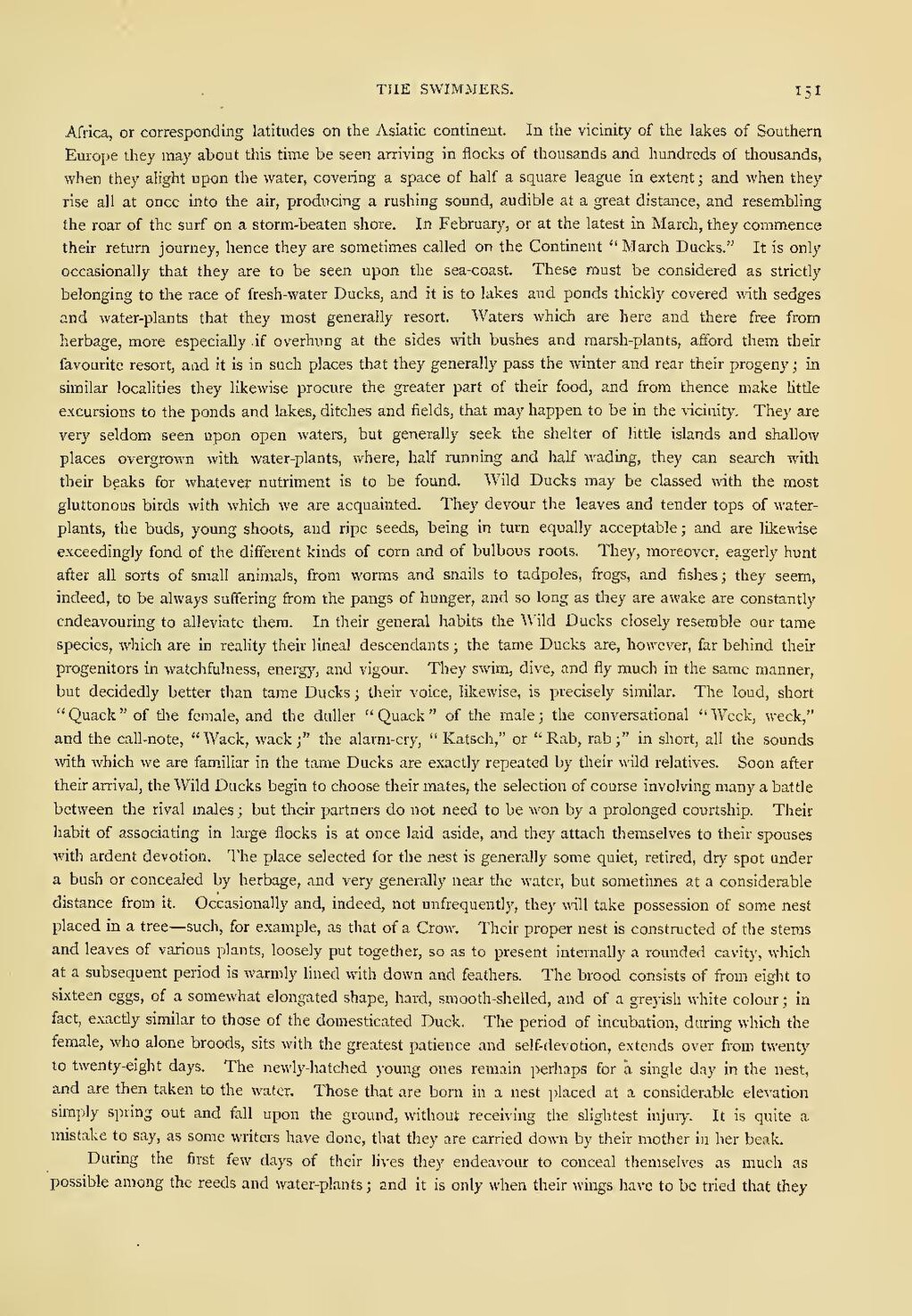Africa, or corresponding latitudes on the Asiatic continent. In the vicinity of the lakes of Southern Europe they may about this time be seen arriving in flocks of thousands and hundreds of thousands, when they alight upon the water, covering a space of half a square league in extent; and when they rise all at once into the air, producing a rushing sound, audible at a great distance, and resembling the roar of the surf on a storm-beaten shore. In February, or at the latest in March, they commence their return journey, hence they are sometimes called on the Continent "March Ducks." It is only occasionally that they are to be seen upon the sea-coast. These must be considered as strictly belonging to the race of fresh-water Ducks, and it is to lakes and ponds thickly covered with sedges and water-plants that they most generally resort. Waters which are here and there free from herbage, more especially if overhung at the sides with bushes and marsh-plants, afford them their favourite resort, and it is in such places that they generally pass the winter and rear their progeny; in similar localities they likewise procure the greater part of their food, and from thence make little excursions to the ponds and lakes, ditches and fields, that may happen to be in the vicinity. They are very seldom seen upon open waters, but generally seek the shelter of little islands and shallow places overgrown with water-plants, where, half running and half wading, they can search with their beaks for whatever nutriment is to be found. Wild Ducks may be classed with the most gluttonous birds with which we are acquainted. They devour the leaves and tender tops of water-plants, the buds, young shoots, and ripe seeds, being in turn equally acceptable; and are likewise exceedingly fond of the different kinds of corn and of bulbous roots. They, moreover, eagerly hunt after all sorts of small animals, from worms and snails to tadpoles, frogs, and fishes; they seem, indeed, to be always suffering from the pangs of hunger, and so long as they are awake are constantly endeavouring to alleviate them. In their general habits the Wild Ducks closely resemble our tame species, which are in reality their lineal descendants; the tame Ducks are, however, far behind their progenitors in watchfulness, energy, and vigour. They swim, dive, and fly much in the same manner, but decidedly better than tame Ducks; their voice, likewise, is precisely similar. The loud, short "Quack" of the female, and the duller "Quack" of the male; the conversational "Weck, weck," and the call-note, "Wack, wack;" the alarm-cry, "Katsch," or "Rab, rab;" in short, all the sounds with which we are familiar in the tame Ducks are exactly repeated by their wild relatives. Soon after their arrival, the Wild Ducks begin to choose their mates, the selection of course involving many a battle between the rival males; but their partners do not need to be won by a prolonged courtship. Their habit of associating in large flocks is at once laid aside, and they attach themselves to their spouses with ardent devotion. The place selected for the nest is generally some quiet, retired, dry spot under a bush or concealed by herbage, and very generally near the water, but sometimes at a considerable distance from it. Occasionally and, indeed, not unfrequently, they will take possession of some nest placed in a tree—such, for example, as that of a Crow. Their proper nest is constructed of the stems and leaves of various plants, loosely put together, so as to present internally a rounded cavity, which at a subsequent period is warmly lined with down and feathers. The brood consists of from eight to sixteen eggs, of a somewhat elongated shape, hard, smooth-shelled, and of a greyish white colour; in fact, exactly similar to those of the domesticated Duck. The period of incubation, during which the female, who alone broods, sits with the greatest patience and self-devotion, extends over from twenty to twenty-eight days. The newly-hatched young ones remain perhaps for a single day in the nest, and are then taken to the water. Those that are born in a nest placed at a considerable elevation simply spring out and fall upon the ground, without receiving the slightest injury. It is quite a mistake to say, as some writers have done, that they are carried down by their mother in her beak.
During the first few days of their lives they endeavour to conceal themselves as much as possible among the reeds and water-plants; and it is only when their wings have to be tried that they
